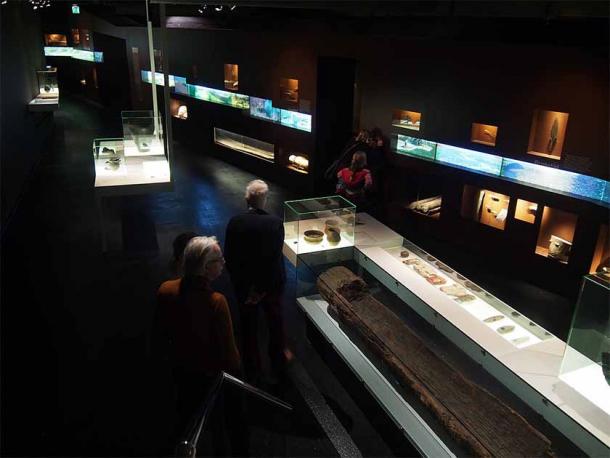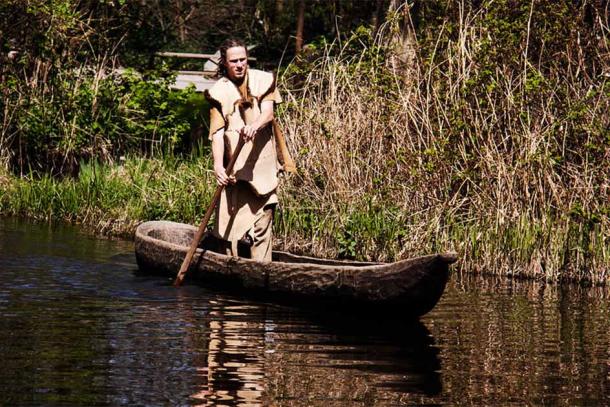One of the most interesting artifact discoveries was the finding of the Pesse canoe in 1955. This unique boat is considered to be the oldest boat in existence and is estimated to be around 10,000 years old. This essential discovery helped shed more light on the importance and usage of boats in the European Prehistoric Age.
Before the discovery of the Pesse canoe, little was known about the use of boats or similar transportation tools in the Prehistoric Age. So where was this boat found, and how do we know how it was used? How do we even know how old it is, and what does this tell us about humans during that age?

Present-day dugout canoes on the shores of Lake Malawi, Africa, where the second-oldest dugout, the Dufuna canoe, was found in 1987, which was about 8,000 years old. (i_pinz / CC BY-SA 2.0)
An Odd Tree Log Becomes the Fascinating Pesse Canoe
The discovery of the Pesse canoe is a fascinating one, as it was an artifact that was not intentionally found. Rather than being dug up by an archaeologist or historian, the ancient boat was discovered by a worker during the 1955 building of the Dutch A28 motorway in The Netherlands. The worker had been moving peat near the village of Pesse when he discovered the canoe with his excavator.
Thinking the boat was nothing more than a rotting tree log, he at first ignored it. But when he mentioned the “tree log” to a local Pesse farmer, Hendrik Wanders, Wanders decided to go and see the log for himself. Noticing that the supposed “tree log” was a bit unusual, he decided to take the discovery home for further analysis. After observing the carving marks on the log, he took it to the University of Groningen to be inspected by experienced researchers.
- Rare 1000-Year-Old Maya Canoe Found in Yucatan Cenote
- Oldest and First ‘Wampo’ Ritual Canoe Burial Found in Argentina
Researchers concluded that the unique “tree log” was in fact a type of ancient canoe known as a ‘dugout canoe’, which were regularly used in ancient civilizations. It is currently the oldest known boat in existence.

The Pesse canoe on display at the Drents Museum, 2019. (C messier / CC BY-SA 4.0)
To Put Controversy To Rest A Replica Is Made
Researchers identified the boat as a dugout canoe due to its narrow bow and flat bottom. The canoe is 117 inches (297 centimeters) long and 17 inches (43 centimeters) wide. Further analysis determined that the canoe was made from the trunk of a Scots pine tree and was likely carved out with flint or horn tools. Researchers used carbon dating to determine that the canoe was likely built sometime between 8040 and 7520 BC, during the Early Mesolithic Period.
Though an exciting discovery, the Pesse canoe had its fair share of controversy. Many people wondered if the rare discovery was truly a canoe and not some other ancient artifact such as a feeding trough or bath.
Jaap Beuker, an archaeologist and curator at the Drents Museum in Assen, strongly argued for the Pesse canoe’s authenticity, claiming that humans at the time of the canoe’s creation were hunting and gathering rather than farming livestock. In 2001, Beuker decided to put the controversy to rest by building an exact replica of the Pesse canoe. He then tested his replica on water and proved that it did indeed float and function as a canoe.
In addition to his test, comparisons were made to a similar boat found in the village of Dufuna in Nigeria. This boat was found in 1987 and extracted from its site in 1994. Researchers performed carbon dating and determined that the boat is around 8,000 years old, making it the second-oldest boat ever discovered. Its shape, size, and carving patterns are all similar to those of the Pesse canoe, further proving that it is not a feeding trough or other artifact.

A hunter-gatherer on the move in a dugout canoe similar to the 10,000-year-old Pesse canoe. (Hans Splinter / CC BY-ND 2.0)
An Age of Hunting and Gathering
The discovery of a boat this old further proves that ancient humans during the period of the boat’s creation were engaging in hunting and gathering activities including fishing. Canoes would be used to paddle down the river where humans would fish, hunt birds, and gather fruits and vegetables along the water’s edge. The creation of the Pesse canoe indicates that humans around the 8 th millenium BC were exploring their world for additional resources, rather than limiting themselves to only the resources land could provide them.
This canoe also tells us that humans were mostly exploring shallow or peaceful waters such as lakes, marshes, and certain parts of local rivers. Because of the canoe’s size and build, it would not be able to handle troubled waters well and would likely flip or fill with water easily in the presence of waves.
Low-oxygen Peat Bogs: Perfect For Wood Preservation
Researchers speculate that the Pesse canoe was originally preserved due to a lack of oxygen in the peat bog it was found in. Without oxygen, the wood of the canoe was unable to decompose into the surrounding soil. Once oxygen was reintroduced to the canoe, it was put at risk of further damage unless it was preserved some other way.
Scientists decided to freeze-dry the canoe to prevent further decomposition after it was analyzed. This process carefully removed all traces of water in the canoe’s wood fibers so that it would not continue to rot as it sat on display. After being freeze-dried, the canoe was donated to the Drents Museum in The Netherlands, which is located near the canoe’s original discovery location. Now, it is on display at the museum for all those who wish to witness the world’s oldest boat firsthand.
- Hurricane Irma Uncovers a Rare Native American Canoe in Florida
- 1,200-Year-Old Ho-Chunk Dugout Canoe Found In Wisconsin Lake
The Pesse canoe was a fascinating discovery for researchers interested in human evolution. Its existence further proved that humans engaged in fishing, hunting, and gathering around 10,000 years ago. This can help historians further piece together the full picture of how humanity has evolved over time.
If you ever find yourself in The Netherlands, be sure to check out the Pesse canoe at the Drents Museum. It’s certainly a fascinating artifact to see and experience with your own eyes.
Top image: The Pesse canoe, shown here, believed to be the world’s oldest known boat, was made roughly 10,000 years ago in the Mesolithic period, from a Scots pine trunk, in the Netherlands region. Source: Drents Museum / CC BY 3.0
By Lex Leigh